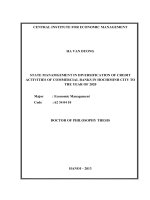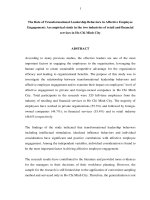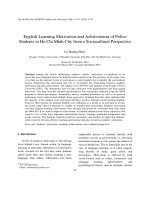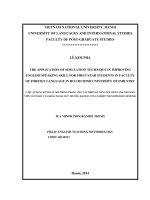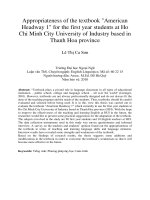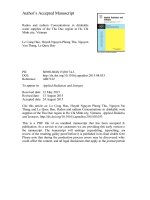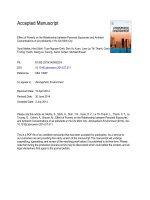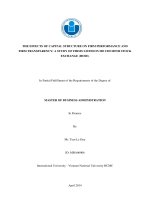English Learning Motivation and Achievement of Police Students in Ho Chi Minh City from a Sociocultural Perspective
Bạn đang xem bản rút gọn của tài liệu. Xem và tải ngay bản đầy đủ của tài liệu tại đây (150.69 KB, 12 trang )
Tạp chí Khoa học ĐHQGHN: Nghiên cứu Nước ngoài, Tập 31, Số 1 (2015) 33-44
33
English Learning Motivation and Achievement of Police
Students in Ho Chi Minh City from a Sociocultural Perspective
Lê Hương Hoa*
People’s Police University, 179A Kha Vạn Cân, Thủ Đức, Ho Chi Minh City, Vietnam
Received 16 October 2014
Revised 03 March 2015; Accepted 06 March 2015
Abstract
: Among the factors influencing students’ studies, motivation is considered to be
one of the most important factors for different achievement levels. The purposes of this study were
(i) to find out the students' levels of motivation to study English, (ii) to identify the sociocultural
factors influencing that motivation and (iii) to investigate the relationship between students'
motivation and their achievement. The subjects were 509 first-year students at the People’s Police
University (PPU). The instruments used for data collection were questionnaires and focus group
interviews. The data from the returned questionnaires was statistically analyzed using the SPSS
program to derive percentages, frequencies, means, standard deviations, as well as to perform
exploratory factor analysis and multiple linear regression. Findings from this study indicated that
the majority of the students were motivated and had a positive attitude toward learning English;
however, their reasons for learning English were utilitarian as a means to an end such as to pass
the exams rather than for pleasure or, simply, to broaden their knowledge. Students' motivation
and their English learning achievement were strongly and positively correlated with each other
(p=.000<.05). If we want to improve achievement, we should influence motivation, especially with
regard to two of the most important motivational factors: learning situational components and
group cohesion. The findings could be useful for researchers and teachers in improving students’
achievement by devising effective teaching and learning strategies to increase students’ motivation.
Keywords: Students’ motivation, academic achievement, socio-cultural perspective.
1. Introduction
∗
∗∗
∗
In life in general, motivation is the driving
force behind every human action. In language
learning in particular, differences in motivation
levels account for the fact that some students
spend more time and energy learning a new
language than others. Motivation has been
_______
∗
Tel.: 84-909193103
Email:
empirically proven to correlate directly with
academic success or achievement, i.e., the more
motivated someone is, the greater the chance of
success he/she has. This is especially true in the
case of language learning, as it often requires
long periods of study, great effort, and
persistence. Motivation is affected by both
social factors such as values, tendencies, and
language learning opportunities; and
psychological factors such as attitudes, desires
L.H. Hoa / Tạp chí Khoa học ĐHQGHN: Nghiên cứu Nước ngoài, Tập 31, Số 1 (2015) 33-44
34
and effort, and language use anxiety. Of all
these factors, students’ purposes for studying
the language, course content, and teaching
methods are of particular importance. A good
learning environment tends to inspire sufficient
motivation in learners so that learning becomes
a self-directed process. However, many learners
sign up for language classes without well-
defined motivations and attitudes [1]. They are
unclear as to why or how languages should be
learnt to further their personal and educational
pursuits. One class might be excited about the
classroom activities, while other classes would
not show much interest. Even within one class,
some students would be interested but others
would not share that enthusiasm. Initially, most
students are enthusiastic about studying English
but this excitement gradually seems to decrease
and, even worse, their academic results appear
to slump correspondingly until the only thing
they want to do is to pass the exam.
In this study, the researcher investigated
students’ motivation to learn a foreign
language, in hopes of answering the following
question:
“What is the relationship between students’
motivation and their academic achievement
from a sociocultural perspective?”
2. Theoretical framework for the study
2.1. Motivation
Motivation is a construct that is difficult to
define. Yet this term is used widely in situations
involving learning a foreign/second language.
Scholars from different backgrounds may
define motivation in different ways. In this
study, Ushioda’s conceptualization of
motivation as a, “socially mediated process” [2:
90] was adopted. This definition was based on
the notions that “learning is constructive rather
than reproductive,” and “learning is a social,
cultural and interpersonal as well as
intrapersonal process” [2: 91].
2.2. Sociocultural perspective on L2 learning
motivation
Motivation theories that focus strongly on
context are often described as sociocultural
theories of motivation. This section considers
socioculturally oriented theories of motivation
and, more broadly, the role of context in
motivation theories. It contrasts sociocultural
theories with more conventional theories,
considers the distinctions between different
sociocultural theories of motivation, and
considers the practical implications of such
theories in motivating students in classroom
situations.
One theoretical tradition in particular that
illustrates the socially constructed nature of
motivation is Vygotskian’s sociocultural theory.
This approach suggests that motivation is (a)
socially negotiated (what it is and how it is
displayed), (b) socially distributed (not just in a
child’s mind), and (c) context specific
(determined by features of the activity setting).
The most obvious implication of this approach
is that motivation must be conceptualized as a
“situated” phenomenon: located not solely
within individuals, but within “systems” of
activities involving other persons,
environments, resources, and goals. From this
perspective, motivation is accomplished, it is
created, it is socially and culturally relative, and
it is context-specific. It is not a unitary
phenomenon, a general, invariant property of
the individual mind, or an abstract property of
individuals; it is manifested in activities,
L.H. Hoa / Tạp chí Khoa học ĐHQGHN: Nghiên cứu Nước ngoài, Tập 31, Số 1 (2015) 33-44
35
involving most prominently, the mediation of
other human beings. In Sivan’s words, “. . . the
individual no longer acts as the instigator of
motivation. Rather, motivation is a socially
negotiated process that results in an observable
manifestation of interest and cognitive and
affective engagement” [3: 210]. Simply put, we
view motivation not as an individual construct
but as a socially and culturally mediated
phenomenon, located not within the student but
in the student’s interactions with others during
specific activities.
2.3. Dornyei’s three -level framework
Learning a language is a very complex
process. Apart from mastering new information
about and knowledge of the language, social
factors and personality traits are also important
factors in L2 learning. A second language is a)
a communication coding system that can be
taught as a school subject; b) an integral part of
the individual’s identity involved in almost all
mental activities; c) the most important channel
of social organization in the culture of the
community where it is used [4]. A good L2
motivational construct should correspond to the
unique nature of the L2 learning process and the
specific language.
Taking Clement’s approach as a basis [5],
and also inspired by Crookes and Schmidt’s
approach of examining motivation at various
conceptual levels [6], as well as other L2
motivation literature and research related to
motives in the learning situation, Dornyei [4]
proposed that the variables or components
derived from different areas or aspects of
psychology should be categorized into three
sets of motivational components: the language
level, the learner level and the learning situation
level. The purpose was to better understand L2
motivation from an educational perspective.
Comparing Gardner’s early conceptualization
[7], which defined motivation in terms of effort,
goals, and favorable attitudes, to Dornyei’s tri-
level system [4] (language level, learner level
and learning situation level), it is apparent that
the latter embraces more components such as
the factors advanced by the achievement and
attribution theories of motivation, extrinsic and
intrinsic factors, the concept of self-efficacy,
and context-specific issues.
The focus of most prior research was the
social and pragmatic aspects of L2 motivation
mainly based on Gardner’s socio-educational
theories. Some researchers and scholars worked
on expanding L2 motivational constructs. For
instance, Brown [8] added intrinsic and
extrinsic motivation to the construct; Dornyei
[9] and Skehan [10] considered the impact of
past successes and failures as a component of
L2 motivation; Clement [5] and Clement and
Kruidenier [11] demonstrated that self-
confidence played an important role in L2
motivation and the learning process. Other
variables, for example, classroom tasks, group
cohesion, course content and teaching
materials, teacher feedback and rewards are
also important components of L2 motivation
([8], [12-17]). A noteworthy merit of Dornyei’s
extended framework of L2 motivation is that
the three levels are in accord with the basic
components of the second language learning
process, and reflect the multifaceted nature of
language.
This framework not only reflects the
multifaceted nature of language (the social
dimension, the personal dimension and the
educational subject matter dimension), but also
corresponds to the three basic components of
the L2 learning process (the L2, L2 learner and
the L2 learning environment). The best feature
of this framework is the combination of internal
and external motivational factors with a
L.H. Hoa / Tạp chí Khoa học ĐHQGHN: Nghiên cứu Nước ngoài, Tập 31, Số 1 (2015) 33-44
36
Gardnerian account of L2 learning motivation.
The introduction of three different levels of
factors allows for the inclusion of motivational
orientations, as well as specific situations
involving the learner and his or her external
context. As can be seen from this model,
motivation not only resides within the
individual, but is also sociocuturally bound.
This is reminiscent of Vygotsky’s sociocultural
theory which posits “learning is a social,
cultural and interpersonal as well as
intrapersonal process” [18: 735]. As the focus
of this study is to explore the relationship
between motivation and academic achievement
from a sociocultural perspective, Dornyei's
framework of L2 motivation was chosen [4].
LANGUAGE LEVEL Integrative motivational subsystem
Instrumental motivational subsystem
LEARNER LEVEL Need for achievement
Self - confidence
Language use anxiety
Perceived L2 competence
Causal attributions
Self-efficacy
LEARNING SITUATION LEVEL
Course-specific motivational components
Teacher-specific motivational components
Group-specific motivational components
Interest (in the course)
Relevance (of the course to one’s needs)
Expectation (of success)
Satisfaction (one has in the outcome)
Affiliative motive (to please the teacher)
Authority type (controlling vs. autonomy - supporting)
Direct socialization of motivation
Modeling
Task presentation
Feedback
Goal - orientedness
Norm and reward system
Group cohesiveness
Classroom goal structure (cooperative, competitive or
individualistic)
Figure 1. Dornyei’s framework of L2 motivation [4: 280]
3. Research Methodology
The study employed both quantitative and
qualitative techniques by utilizing
questionnaires and focus group interviews.
3.1. Instruments
The language learning motivation
questionnaire consisted of 46 items based on
Dornyei’s three-level framework of L2
motivation [4]. The items used in the
questionnaire were based on statements made in
discussions conducted in preparation for this
study, along with existing questionnaires used
in previous research into L2 motivation ([9],
[12]). The participants filled out the
questionnaires by indicating their agreement or
L.H. Hoa / Tạp chí Khoa học ĐHQGHN: Nghiên cứu Nước ngoài, Tập 31, Số 1 (2015) 33-44
37
disagreement with various statements on five-
point Likert scales (1 = strongly disagree; 5 =
strongly agree). All the items were designed to
assess students’ attitudes towards learning
English, their orientations (reasons for learning
a foreign language), need for achievement,
language use anxiety, group cohesion among
the students and their attitudes towards the
language learning environment.
The achievement test for this study was a
written test on the topics and skills covered in
the general English course. The test had two
sections: reading and writing. Most material for
the test was taken directly from the exam
section of the teacher’s book, or adapted from
the students’ book or workbook activities. All
the items on the test were double-checked by
experienced teachers to ensure the reliability
and validity of the test. This achievement test
accounted for 75% of the total semester score
while the other components such as
participation, a presentation, and midterm test
made up the remaining 25%.
The topics for the focus group interviews
were derived from the research questions and
based on the data from the questionnaires with
the aim of gaining in-depth information mainly
about the participants’ motivation levels with
regard to studying English. During the course
of the interview, two kinds of questions, Wh
and Yes/No questions, were used in order to
facilitate the interview process and to enhance
the reliability of the interview data.
3.2. Participants
There were two sample groups of
participants in this study: The respondents to
the questionnaire (n=509) were first year
students. Most of them were 18-20 years of age
and studied English in classes of 50 students
each. The group was highly heterogeneous as
the students came from different backgrounds
and environments, ranging from cities to remote
mountainous areas. At the time of this study,
they were in their first semester at PPU.
All of the interviewees also filled out the
questionnaire. We selected the sample for the
focus group interviews from within the larger
sample group for the questionnaire. The
students enrolled in the D22 course at PPU
were divided into 10 classes. Based on the class
lists, we randomly selected eight students from
each class. 80 students in 10 groups participated
in the interviews. The size of the sample is 16
% of the total number of survey participants.
The purpose of the focus group interviews was
to explore ideas which could not be explained
completely in the questionnaires.
3.3. Procedure
The motivation questionnaires were
administered to all first-year students during a
single class period (n=509) in the first week of
the semester. This was followed by a round of
focus group interviews (n=80). The focus group
interviews were conducted to provide an insight
into the responses recorded on the
questionnaires. All the interviews were
conducted in Vietnamese so that the students
could easily express their opinions without the
hindrance of using English. The interviews
were conducted informally and confidentially
and were all meticulously recorded by the
researcher for later data analysis. The purpose
of the questionnaires and the focus group
interviews was to determine the level of
students’ motivation to study English and to
identify which factors affected their academic
achievement. Their scores for the semester
exam were used to establish a hypothetical
L.H. Hoa / Tạp chí Khoa học ĐHQGHN: Nghiên cứu Nước ngoài, Tập 31, Số 1 (2015) 33-44
38
relationship between their motivation levels and
their academic achievement.
4. Results and discussions
4.1. The PPU students' motivation to learn
English
The students' motivation to learn English
was determined using data collected from
questionnaires drawn up in accordance with
Dornyei’s three-level framework of L2
motivation ([9], [12]) and focus group
interviews. The results of this study confirmed
the validity of Dornyei’s categorization of
motivational components into three levels: the
Language level (instrumental and integrative
motivational subsystems), the Learner level
(individual motivational characteristics) and the
Learning situation level (situation - specific
motives relating to the course and social
learning environment).
A high rating for each item reflected a
positive attitude towards learning English
which, in turn, indicated a high level of
motivation to learn the language. We focused
on measuring the PPU students' motivation to
learn English through the use of ascending
rankings from the instrumental orientation,
knowledge orientation, and attitude towards
learning English, anxiety when using English to
complete tasks while studying in groups.
Overall, they rated their motivation quite
highly, from 3.5 to 4 on a scale of one to five:
(1) strongly disagree, (2) disagree, (3) neutral,
(4) agree, (5) strongly agree.
Table 1. Frequencies and Descriptive Statistics of motivation to learn English
Factors
Overall Mean
Score
Std. Deviation
Instrumental Orientation 3.89 .890
Knowledge Orientation 3.76 .945
Attitudes towards Learning English 3.69 .945
English Class Anxiety 3.78 .929
Perceived Group Cohesion in the
Student
4.03 .879
English Teacher Evaluation 4.34 .976
English Course Evaluation 4.37 .939
Need for achievement 4.33 .883
The analysis of the data from the focus
group interviews supported the findings of the
questionnaires. As one of the universities
belonging to the armed forces, all the students
here have to live in the dormitory during the
five-year study period except for summer and
Tet holidays. All of the freshman students
found everything strange. They were unfamiliar
with the new school and new friends who come
from different places. PPU students come from
an area encompassing Quang Tri in central
Vietnam to the Southern provinces of the
Mekong Delta. This is a hugely heterogeneous
area with vastly different cultural traditions and
in which different dialects of Vietnamese are
spoken. This means that the incoming students
face a range of cultural barriers. Their
motivation to study English was increased by
L.H. Hoa / Tạp chí Khoa học ĐHQGHN: Nghiên cứu Nước ngoài, Tập 31, Số 1 (2015) 33-44
39
the availability of various learning forums such
as clubs or study groups to help students
overcome their initial hesitation to interact with
each other due to the above mentioned cultural
barriers and concerns that their pronunciation
might not be clear.
When they came together at university,
they tended to cooperate with each other.
Consequently, this teamwork had a positive
effect on group members. Many students said
that they preferred learning English in pairs or
groups, that working together improved their
English skills, and that they hoped
to
have
more opportunities to practice English in
groups or pairs. Most of the students realized
that the more they worked in groups or pairs,
the more group cohesion they developed. In
terms of the interaction between teachers and
students, the results revealed that teachers
succeeded in sharing their knowledge and
motivating their students. In other words,
teaching methods and the interaction between
learners and teachers had a considerable impact
on learners’ motivation. Although English is
considered to be a required component of the
curriculum, students clearly felt a desire to
obtain good results.
However, the results also showed that
students held many conflicting opinions about
English. English is a mandatory subject which
students need to take in order to meet the
demands of social trends or professions, rather
than a self-motivated or elective subject. Some
students admitted that they forced themselves to
study English because they needed to pass it in
order to meet the university's requirements.
4.2. The relationship between students’
motivation to learn English and their academic
achievement
In statistics, exploratory factor analysis
(EFA) is a common technique utilized for social
science research to describe the variance of
several measured variables in terms of a smaller
number of underlying latent variables (factors)
to derive greater meaning while still retaining
most of the data from the original list of
variables [19]. We utilized this technique to
refine and reduce the total of 46 items related to
the motivation of the People's Police University
students to learn English.
The thirteenth EFA revealed that 26
indicators satisfied all the criteria for the EFA
model and six main factors were extracted. This
provided a simple structure of observable
clusters of variables relating to an underlying
factor based on the above theoretical orientation
and which accounted for 69.268 % of the
variance. Each factor was assigned a name
representing the related cluster of observed
variables as shown below.
Table 2. Rotated Component Matrix for the thirteenth EFA
Items
Components
1 2 3 4 5 6
I am satisfied with what I am studying .871
My teacher spends a lot of time planning the lessons .871
My teacher is very strict with students .619
My English teacher has a dynamic and interesting
teaching style
.544
I look forward to going to class because my English
teacher is so good
.574
My teacher's teaching style is very attractive .898
Satisfaction with the English class and
teacher’s role
L.H. Hoa / Tạp chí Khoa học ĐHQGHN: Nghiên cứu Nước ngoài, Tập 31, Số 1 (2015) 33-44
40
My teacher takes students' learning styles into account .823
My teacher cares about my progress on the course .822
The syllabus is appropriately designed .788
My teacher is very enthusiastic about teaching .699
The course is directly relevant to my major .699
Learning situational components
I get nervous and confused when I speak in my
English class
.969
It embarrasses me to volunteer answers in my English
class
.748
I am afraid that other students will laugh at me when I
speak English
.697
If I were to participate in another group like this one, I
would like it to include people who are very similar to
those in this group
.697
Anxiety
Group activities and pair work in English are very
effective
.764
One of the most important things in this class is
getting along with other students
.764
I like English learning activities in which students
work together in pairs or groups
.856
I prefer to work with other students .788
Working with other students enhances my learning
experience
.540
Group cohesion
Because an educated person is supposed to be able to
speak English
.976
So that I can read English books, newspapers, or
magazines
.976
Because I will need it for career development .737
Because I think I'll need it for further studies .730
Motivational
orientation
I do not particularly like the process of learning
English and I do it only because I may need the
language
.906
Because I would like to learn as many foreign
languages as possible
Attitudes towards English
learning
.905
Through factor analysis, six factors which
influenced academic results at the People's Police
University were identified. Using each of the six
newly identified factors separately, we calculated
the Pearson correlation coefficients (r) for the 6
factors and used them in a multiple regression
equation to evaluate the effect of student
motivation on their academic achievement.
To answer the question “What is the
relationship between motivation and
achievement from a sociocultural perspective?”
Multiple Regression Model (MLR) was used.
Research hypothesis Ho: Their motivation
has no correlation with their academic
achievement, which means none of the factors
have any correlation.
X1. Satisfaction with English class and
teacher’s role has no correlation with their
academic achievement
X2. Learning situational components have
no correlation with their academic achievement
X3. Anxiety has no correlation with their
academic achievement
L.H. Hoa / Tạp chí Khoa học ĐHQGHN: Nghiên cứu Nước ngoài, Tập 31, Số 1 (2015) 33-44
41
X4. Group cohesion has no correlation with
their academic achievement
X5. Motivational orientation has no
correlation with their academic achievement
X6. Attitudes towards English learning have
no correlation with their academic achievement
Table 3. Multiple Linear Regression loading
Coefficients (a)
Unstandardized
Coefficients
Standardized
Coefficients
Correlations
Collinearity
Statistics
Model
B
Std.
Error
Beta
t Sig.
Zero-
order
Partial
Part
Tolerance
VIF
(Constant) 7.155 .044 162.209
.000
Satisfaction
with English
class and
teacher's role
.149 .044 .252 1.119 .001
.052 .353 .052
.600 1.671
Learning
situational
components
and
expectation
.173 .044
.461
.227 .001
.511 .441 .011
.670 1.433
Anxiety .236 .044 .318 .812 .001
.438 .438 .038
.701 1.354
Group
cohesion
.332 .044
.354
.734 .001
.334 .235 .434
732 1.457
Motivational
orientation
.272 .044 .224 .508 .001
.324 .394 .309
.734 1.892
1
Attitudes
towards
English
learning
.219 .044 .221 .454 .001
.321 .354 .317
.732 1.578
According to the regression loading table,
variables X1 to X6 had positive effect on Y
(achievement), because their regression
loadings B had a statistically significant p =
0.001. When we compared the effect of the 6
variables on Y, X2 (Learning situational
components) had the most important effect on
Y with a beta of X2 = 0.461, following by X4
(Group cohesion) with a beta of X4 = 0.354, X3
(Anxiety) with a beta of X3 = 0.318, X1
(Satisfaction with English class and teacher's
role) with a beta of X1 = .252, X5
(Motivational orientation) with a beta of X5 =
.224 and lastly X6 (Attitudes towards English
learning) with a beta of X6 = .221.
The identified correlation function between
motivation and academic achievement is shown
below:
Y = 7.155+ 0. 252. X1 + 0. 461. X2 + 0.
318. X3 + 0. 354. X4 + 0.224.X5 + 0.221.X6.
The loadings all being positive indicated that
the motivation to study had a positive
correlation with academic achievement, when
the former increased, the latter also increased,
and vice versa.
L.H. Hoa / Tạp chí Khoa học ĐHQGHN: Nghiên cứu Nước ngoài, Tập 31, Số 1 (2015) 33-44
42
In a nutshell, the Ho hypothesis was
rejected. The results showed that motivational
factors had a positive effect on academic
achievement.
In short, after running EFA, the
questionnaire’s eight initial factors were refined
down to six ones. When considering the level of
endorsement of each of the factors, it was clear
that the students were motivated to study
English. Higher rankings for Learning
situational components and Group cohesion
indicated that the learning environment had a
huge impact on motivation which resulted in
better achievement. Consequently, if we want to
improve achievement, we should manipulate
motivation, especially these two most important
and influential factors.
5. Conclusion
The results from the questionnaires and
focus group interviews showed that the
majority of the students involved in this study
were motivated and had a positive attitude
toward learning English; however, their reasons
for learning English were more instrumental in
nature with utilitarian purposes such as passing
the exams rather than studying for pleasure or
broadening their knowledge. They were not
motivated to study English because of external
pressures such as getting a better job or salary
or understating their specialties. This is
understandable since each PPU student is
guaranteed a position after graduation, which
lowers students’ motivation to study English to
some extent.
Motivation and English learning
achievement were positively correlated with
each other. The results of the study indicated
that there was a strong positive relationship
between student achievement and motivation.
This might be due to the fact that the students
who got high grades for English tended to be
interested in learning English. The students’
achievement had a bolstering effect on their
motivation. It enabled students to use the target
language more often, encouraged
communication with others in the language and
created a safe classroom environment for
engaging in discussions and other
communicative activities.
The investigation into the students’
motivation levels to study English at the Police
University also showed that motivation is a
socially mediated process. An individual’s
motivation comes not only from within, but is
also socioculturally mediated through
interacting with others in the broader social
context. It means that motivation is derived
from specific aspects of the learning situation.
As Oxford and Shearin [20] argue, while the
source of motivation may not be of particular
importance to scholars, it is very important in a
practical sense to teachers who want to
stimulate students’ motivation. “Without
knowing where the roots of motivation lie, how
can teachers water those roots?” [20: 15]. The
application of Dornyei’s model [4] to
investigate the motivation of Police students in
this case relates to Oxford and Shearin’s [20]
recommendation that foreign language learning
be improved or bolstered with advice to
teachers regarding how to motivate students at
each of the three levels in the model. At the
same time, the results also identify which of the
factors cause demotivation and affect
motivation most. This helps us come up with
appropriate ways to increase students’
motivation and design effective strategic plans
for English teaching and learning.
L.H. Hoa / Tạp chí Khoa học ĐHQGHN: Nghiên cứu Nước ngoài, Tập 31, Số 1 (2015) 33-44
43
However, this was a preliminary study to
determine the students’ motivation level at PPU
after they completed their first semester of
English studies. This procedure will be repeated
with the same group of students in the second
semester to identify the dynamic aspects of
motivation and to confirm or reject the
hypothetical relationship between motivation
and academic achievement identified in the first
semester.
References
[1] Dornyei, Z. and Otto, I. (1998). Motivation in
action: A process model of L2 motivation.
Working Papers in Applied Linguistics (London:
Thames Valley University), 4: 43-69.
[2] Ushioda, E. (2003). Motivation as a socially
mediated process. In D. Little, J. Ridley & E.
Ushioda (Eds.), Learner autonomy in the foreign
language classroom: Teacher, learner, curriculum
and assessment (pp. 90 -102).Dublin: Authentik.
[3] Sivan, E. (1986). Motivation in social
constructivist theory. Educational Psychologist,
21,209-233.
[4] Dornyei, Z. (1994a).Motivation and motivating in
the foreign language classroom. The Modern
Language Journal, 78, 273-284.
[5] Clement, R. (1980).Ethnicity, Contact and
Communicative Competence in a Second
Language in H. Giles, W. P. Robinson & P.M.
Smith (cds.) Language: Social psychological
perspective. Toronto: Pergamon Press.
[6] Crookes, G., & Schmidt, R. W. (1991).
Motivation: Reopening the research agenda.
Language Learning, 41, 469 - 512.
[7] Gardner, R. C. (1985). Social psychology and
second language learning. London: Edward
Arnold Ltd.
[8] Brown, H. D. (1994). Teaching by Principles
.Prentice Hall, Englewood Cliffs, NJ
[9] Dornyei, Z. (1990). Conceptualizing motivation in
foreign language learning. Language Learning,
40, 45-78.
[10] Skehan, P. (1989). Individual differences in
second language learning. Great Britain: Edward
Arnold.
[11] Clement, R. and Kruidenier, B.G. (1985).
Aptitude, attitude and motivation in second
language proficiency: a test of Clement's model,
Journal of Language and Social Psychology, 4:
21-38.
[12] Clement, R., Dornyei, Z., & Noels, K. A. (1994).
Motivation, self-confidence, and group cohesion
in the foreign language classroom. Language
Learning, 44, 417- 448.
[13] Crookes, G., & Schmidt, R. W.
(1991).Motivation: Reopening the research
agenda. Language Learning, 41, 469 - 512.
[14] Julkunen, K. (1989). Situation- and task-specific
motivation in foreign-language learning and
teaching (Publication in Education No. 6).
Joensuu, Finland: University of Joensuu.
[15] Ramage, K. (1990). Motivational factors and
persistence in foreign language study: a descriptive
analysis. Language Learning, 40, 189-219.
[16] Skehan, P. (1989). Individual differences in
second language learning. Great Britain: Edward
Arnold.
[17] Skehan, P. (1991). Individual differences in
second language learning. Studies in Second
Language Acquisition, 13, 275-298.
[18] Shuell, T. J. (1996). Teaching and learning in a
classroom context. In D. C Berliner & R. C.
Calfee (Eds.). Handbook of educational
psychology (pp.726-764). New York: Macmillan.
[19] Hair & ctg. (1998), Multivariate Data Analysis,
Prentice-Hall International, Inc.
[20] Oxford, R., & Shearin, J. (1994). Language
learning motivation: Expand the theoretical
framework. The Modern Language Journal, 78,
12-28.
L.H. Hoa / Tạp chí Khoa học ĐHQGHN: Nghiên cứu Nước ngoài, Tập 31, Số 1 (2015) 33-44
44
Động cơ và kết quả học tập môn tiếng Anh của sinh viên
trường Đại học CSND TP. Hồ Chí Minh
theo quan điểm văn hóa xã hội
Lê Hương Hoa
Trường Đại học Cảnh sát Nhân dân TP. Hồ Chí Minh
179A Kha Vạn Cân, Quận Thủ Đức, TP. Hồ Chí Minh, Việt Nam
Tóm tắt: Trong số những yếu tố ảnh hưởng đến kết quả học tập của sinh viên, động cơ được xem
là một yếu tố quan trọng. Mục tiêu chính của nghiên cứu này là xác định mức độ động lực học tập, xác
định những yếu tố văn hóa xã hội ảnh hưởng đến động lực học tập và mối liên hệ giữa động lực học
tập với kết quả học tập môn tiếng Anh của sinh viên trường Đại học CSND. Khách thể nghiên cứu bao
gồm 509 sinh viên năm thứ nhất. Công cụ thu thập số liệu là bảng hỏi và phỏng vấn nhóm. Các
phương pháp sử dụng để phân tích số liệu bao gồm thống kê mô tả để xác định động lực học tập tiếng
Anh của sinh viên, dùng phân tích nhân tố để xác định các thành tố của động lực và dùng phép tính hồi
quy đa biến để xác định mối liên hệ giữa động lực học tập và kết quả học tập. Kết quả nghiên cứu cho
thấy phần lớn sinh viên đều có động lực và thái độ tích cực học tập môn tiếng Anh. Tuy nhiên, lý do
của việc học tiếng Anh chỉ là để đạt điểm theo quy định chứ không phải vì yêu thích môn học này hay
vì muốn mở rộng kiến thức. Kết quả phân tích cho thấy rằng động lực tương quan thuận với kết quả
học tập, trong đó cần chú trọng hai thành tố tác động đến động lực học tập là môi trường học và liên kết
nhóm. Kết quả nghiên cứu sẽ là nguồn tham khảo hữu ích giúp cho giảng viên cũng như nhà nghiên cứu
có biện pháp phù hợp và hữu hiệu nhằm tăng động lực học tập tiếng Anh cho sinh viên của trường.
Từ khóa: Động lực học tập của sinh viên, kết quả học tập, quan điểm văn hóa xã hội.
